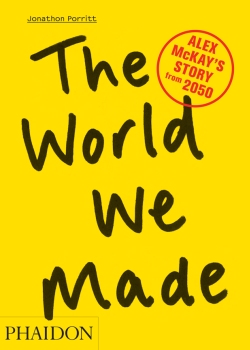 Alex McKay is from the future and he has a story to tell.
Alex McKay is from the future and he has a story to tell.
Looking back from the year 2050, his recollection of personal experiences and world history are found in the book, The World We Made, written by Jonathon Porritt, sustainability guru and Founder Director of Forum for the Future.
Reading the book is like choosing the red pill in the Matrix film, once you choose to take the red pill, you go down the rabbit hole and end up in a different world and there is no turning back. Except in this case, the world is actually bright green and positive.
What would our sustainable future look like, if we actually take action?
Jonathon paints a vivid picture of the world in 2050 with his protagonist, Alex McKay, sharing his story and describing how we ended up with a positive, upbeat and sustainable future. Hang on for the ride down the rabbit hole, as we share a glimpse of Alex’s story.
Climate Change
A major step towards reducing carbon emissions was the signing of the Houston Concord in 2020, a binding agreement supported by every nation. The United States finally turned around on climate change, after considering the threat of energy security and extreme weather events. By 2050, global emissions dropped to around 84% of the 2020 level.
The world was unable to restrict average temperature increase to below 2°C, but was on track to stay below an increase of 3°C before the end of the century, averting the risk of runaway climate change. This was achieved by focusing on energy efficiency and renewable energy, reducing soot pollution from inefficient cooking stoves, and stopping the cutting down of our forests.
The first Geoengineering Summit in 2022 was held in Bangladesh and formally ushered in the era of geoengineering. Regulatory structures were put in place and schemes such as direct air capture to scrub carbon dioxide from air, ocean fertilisation, and biochar were conducted.
Energy
Peak oil finally came and oil production was reduced from a peak of 76 million barrels a day in 2017 to just 4 million barrels in 2050, which was still used in aviation, shipping and high-value chemicals production. By the early 2020s, renewable energy, energy efficiency and advances in energy storage technologies helped the world move away from oil.
Algae-based fuel and biomass helped offset some of the oil demand, and thousands of large-scale solar plants are found all over the world with two main solar technologies, photovoltaics and concentrated solar power, generating about 30% of total electricity demand.
During the transition to renewables, coal was eventually replaced by gas simply because gas was more cost-effective and had lower emissions. Nuclear energy also lost favour after the threat of a series of attempted cyber and terrorists attacks on nuclear reactors.
Agriculture, Food and Water
The 2017 Water Riots and the Great Famine of 2025 highlighted the importance of water and food security for many countries. There were improvements in water irrigation, conservation, purification and desalination.
The world’s population of 8.6 billion people is now reasonably well fed, with the breakthrough of nitrogen-fixing wheat and increasing productivity on small farms. Urban farming and community farms are common, and all the fish comes from sustainable sources.
Travel and Transport
Electric vehicles powered with lithium-air batteries are the market majority, while vehicles with the internal combustion engine rely on second generation biofuels and algae-based biofuels as liquid fuel.
The aviation industry introduced more green fuels such as 70/30 biofuel/kerosene, all-electric and hybrid electric planes, and airships. All nations also signed up to the Global Aviation Carbon Cap, an emissions trading scheme for aviation.
The shipping industry managed to reduce fuel consumption and carbon emissions through improved ship design and engines, cleaner fuel, waste heat recovery systems, slower speeds and smarter logistics.
Consumption
The age of selfish consumption was over by the 2020s, and replaced by collaborative consumption, where traditional sharing, renting, lending and bartering are empowered by technology and peer-to-peer networks, which made personal ownership less important.
Our Future in 2050
Alex’s story of what the world looks like in 2050 and the key events, technologies and lifestyle revolutions that shaped our future, might seem far from our current reality. Is it too good to be true?
We prefer to believe in Alex’s bright green future, where individuals, communities, businesses and governments come together to create the sustainable future we want to see despite the challenges and mistakes along the way. The future is what we create, not something that happens to us.
Take the red pill today by reading the book, The World We Made by Jonathon Porritt, and see for yourself what a hopeful, positive and sustainable future looks like. It’s worth the read (and ride).
Image credit: The World We Made book cover, Phaidon
